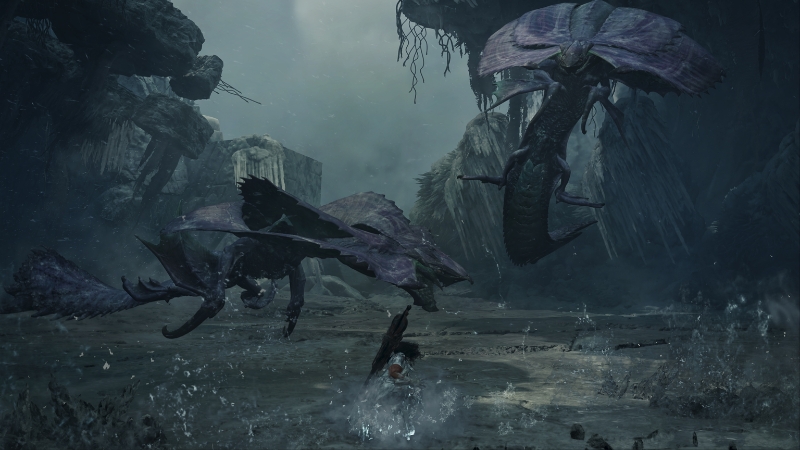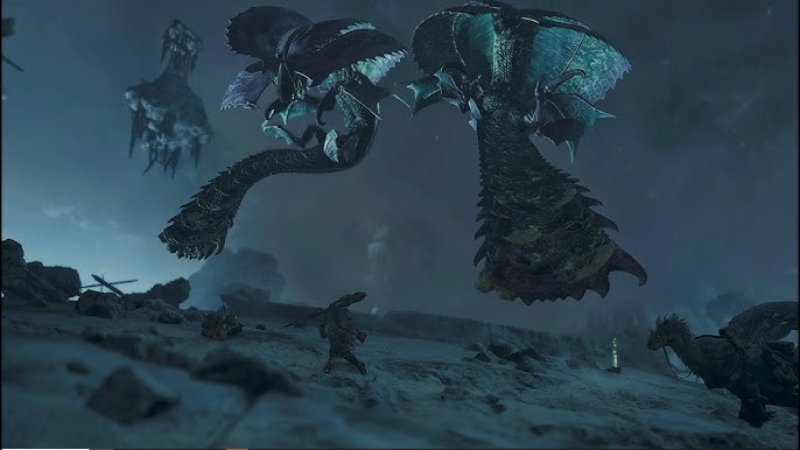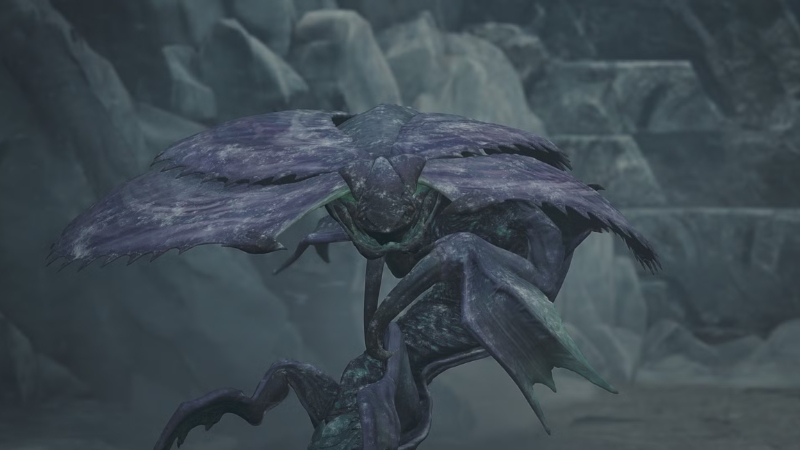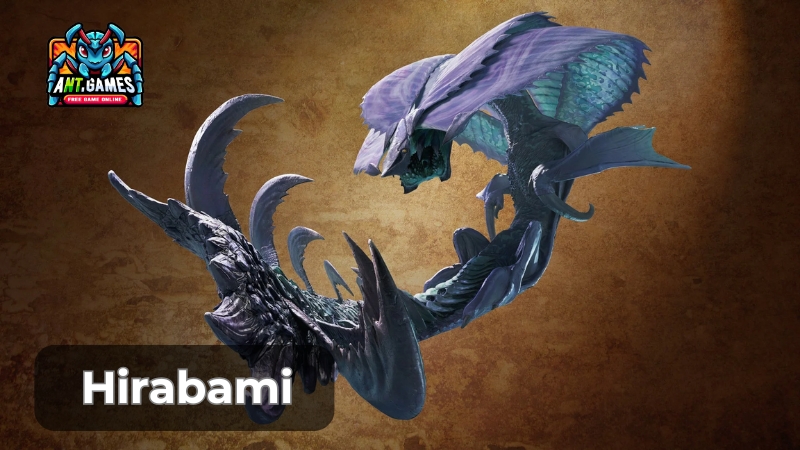In the frigid heights of the Iceshard Cliffs, Hirabami, the Wind Scissors Wyvern, stands out as a mesmerizing new Leviathan in Monster Hunter Wilds. Unlike traditional winged monsters, Hirabami uses a unique wind-catching membrane to levitate, gliding with deadly agility. Its pack-hunting behavior, where it darts alongside others in coordinated swarms, makes every encounter unpredictable and thrilling.
This guide delves into Hirabami’s physiology, combat strategies, and lore, preparing you to take on this elusive aerial predator. Whether you’re crafting its powerful armor or mastering its dynamic battle patterns, Hirabami promises a hunt that will push your skills to the limit.
Hirabami’s Physical Characteristics
Hirabami is a medium-sized Leviathan with a distinctive, almost alien appearance, reminiscent of Somnacanth but uniquely adapted for aerial dominance. Its dark purple body, accented with cyan shades, is both sleek and menacing.
The most striking feature is its large, rubbery membrane extending from its head to its shoulders, which catches the wind to keep it aloft. Its head is pointy, covered in segmented plates, with a lower jaw that splits in two, revealing a brightly colored mouth. Small, pupil-less white eyes add to its eerie presence.
Key physical traits include:
- Finned Arms: Each arm has a fin from elbow to hand, ending in a sickle-shaped claw for slashing.
- Small Back Legs: Thin legs with flat pads, suited for brief ground contact.
- Scissor-Like Tail: A thin base thickens into a tail with multiple clamping claws, resembling razor blades.
- Size: Medium for a Leviathan, making it agile yet formidable.
This design allows Hirabami to thrive in the windy Iceshard Cliffs, where it clings to walls or ceilings when resting (Kiranico). Its physiology supports its role as a swift, aerial predator, distinguishing it from ground-based Leviathans.

Hirabami’s Behavior and Combat Abilities
Hirabami is a territorial predator that often hunts in packs, making it a formidable foe in Monster Hunter Wilds (IGN). Its ability to levitate without wings, using its neck membrane, allows it to maneuver seamlessly between ground and sky. When nesting, Hirabami clings to cliffs, using its scales or foreclaws, only to spring into action when threatened. Its pack behavior means hunters may face multiple Hirabami at once, requiring strategic crowd control.
Key combat abilities include:
- Tail Swipes: Slashes with its scissor-like tail, dealing high damage.
- Ice Spitting: Launches small ice chunks, inflicting Frostblight. ascended to the top of the page.
- Aerial Charges: Dives from the sky at high speed, aiming to knock hunters down.
- Rapid Spin Attack: Spins rapidly in the air, striking with its tail blades.
Hirabami’s weaknesses are:
- Elemental: Fire (2-star), Thunder (1-star), Water (1-star), Dragon (1-star); resistant to Ice.
- Status: Poison (3-star), Sleep (3-star).
Counters include dodging its aerial dives and using status effects like Poison or Sleep to ground it. Destroying its neck membrane temporarily disrupts its levitation, creating openings for attacks.
| Hitzone | Fire | Thunder | Water | Dragon | Ice |
| Head | 2 | 1 | 1 | 1 | 0 |
| Neck | 2 | 1 | 1 | 1 | 0 |
| Tail | 2 | 1 | 1 | 1 | 0 |

Where to Encounter Hirabami in the Game
Hirabami is primarily encountered in the Iceshard Cliffs, a rugged, icy region in Monster Hunter Wilds (Monster Hunter Wiki). It appears in various quests, ranging from story missions to special event quests. Notable appearances include:
- Winds of the Cliffs: A Master Rank story quest introducing Hirabami.
- A Silent Flash: An event quest during the Festival of Accord: Blossomdance (April 22–May 6, 2025), featuring enhanced rewards.
- Arch-Tempered Hirabami: Introduced in Title Update 1, offering tougher challenges and unique materials.
| Quest Name | Difficulty | Type | Rewards |
| Winds of the Cliffs | Master Rank | Story Quest | Hirabami Materials |
| A Silent Flash | High Rank | Event Quest | Enhanced Materials |
| Arch-Tempered Hirabami | Master Rank | Arch-Tempered Quest | Rare Materials |
Hunters can find Hirabami nesting in groups along cliffs, requiring careful navigation to avoid being overwhelmed by its pack tactics. Maps showing its spawn points are recommended for precise tracking.
Discover: 48 Monster in Monster Hunter Wilds
Combat Strategies for Defeating Hirabami
Defeating Hirabami requires preparation and precision, given its aerial agility and pack tactics (The Gamer). Here are detailed strategies:
Weapon Choices
- Ranged Weapons: Light and heavy bowguns excel at hitting Hirabami’s weak points from a distance.
- Melee Weapons: Insect glaives and lances offer reach to strike its head and neck while airborne.
- Elemental Advantage: Equip Fire or Thunder weapons for maximum damage.
Tactics
- Target Weak Points: Focus on the head, neck, and tail, which are most vulnerable to Fire (2-star).
- Status Effects: Use Poison or Sleep (3-star weaknesses) to immobilize Hirabami, creating attack windows.
- Counter Aerial Attacks: Dodge its dives and spins, then counter when it lands or pauses.
- Disrupt Levitation: Destroying the neck membrane grounds Hirabami temporarily.
Item Usage
- Flash Pods: Knock Hirabami out of the air for a brief stun.
- Cleansers: Counter Frostblight from its ice attacks.
- Large Dung Pods: Separate Hirabami from its pack to manage numbers.
- Buffs: Armorcharm, Powercharm, Armorskin, and Demondrug boost survivability.

For solo hunts, prioritize mobility and status effects. In multiplayer, assign roles: one hunter draws aggro while others target weak points. Community feedback emphasizes Flash Pods as a game-changer, with one player noting, “Hirabami’s aerial phase is brutal, but Flash Pods make it manageable!”
Official In-Game Description and Lore
Official Description: “Leviathans that inhabit the Iceshard Cliffs. They have sharp, pincer-like tails and peculiar membranes on their necks that catch the wind and keep them aloft.” (Kiranico)
In the lore of Monster Hunter Wilds, Hirabami is a dominant predator in the Iceshard Cliffs, shaping the region’s ecosystem. Its territorial nature leads to frequent clashes with other monsters, making it a key player in the Forbidden Lands’ food chain. Its pack behavior and aerial prowess suggest a highly evolved species, adapted to the harsh, windy environment. Some hunters speculate it may have a rivalry with other apex predators, though specific details remain part of the game’s unfolding narrative.

Discover more types of Large Monsters:
Fascinating Facts and Trivia About Hirabami
Hirabami isn’t just a fearsome adversary—it also has a rich background and an intriguing design that has captured the attention of both developers and players alike. Let’s dive into some fascinating facts about this aerial Leviathan.
- Name Etymology: “Hira” may derive from Japanese for “flat” or “blade,” while “Bami” could relate to “wind” or “cutting,” reflecting its tail and levitation (Monster Hunter Wilds Wiki).
- Fan Nicknames: Known as “Sky Scissors” among players for its tail and aerial attacks.
- Development Insight: Capcom designed Hirabami’s pack behavior to challenge hunters’ situational awareness, a first for Leviathans.
- Community Buzz: An X post by @ES4613424423 (X Post) noted Hirabami’s role as a narrative milestone, sparking discussions about its difficulty.
These tidbits highlight Hirabami’s unique place in both the game and its community, with players sharing strategies and fan art to celebrate its design.
Hirabami, the Wind Scissors Wyvern, stands as a formidable challenge in Monster Hunter Wilds, blending aerial finesse with relentless pack tactics. Its unique levitation, scissor-like tail, and unpredictable behavior make every encounter a thrilling test for any hunter.
Whether you’re forging its powerful armor or learning to master its complex attack patterns, taking down Hirabami is a rewarding experience. Prepare your gear, venture into the Iceshard Cliffs, and let this aerial predator sharpen your skills. For even more monster-slaying excitement, dive into our other Monster Hunter Wilds guides and continue your adventure across the Forbidden Lands.





